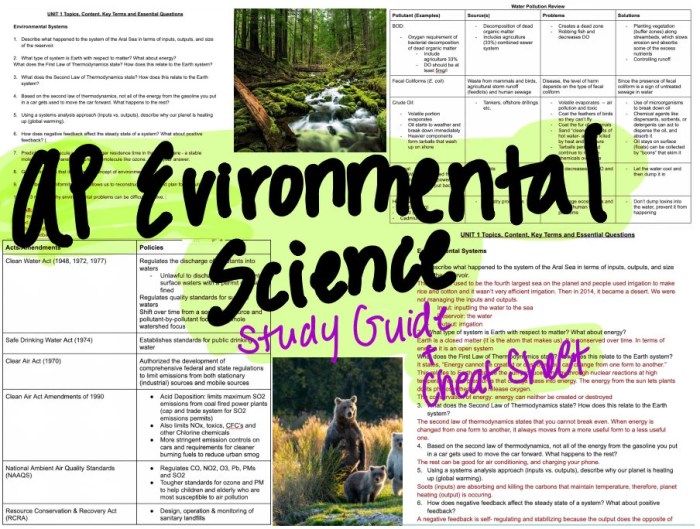The AP Environmental Science Cheat Sheet provides a comprehensive overview of the fundamental concepts, issues, and solutions related to environmental science. This cheat sheet is designed to assist students in their preparation for the AP Environmental Science exam and serves as a valuable resource for anyone seeking to enhance their understanding of environmental science.
This cheat sheet covers a wide range of topics, including the fundamental principles of environmental science, major environmental issues facing the planet, environmental policies and regulations, sustainable solutions to environmental problems, environmental ethics and values, environmental education and outreach, and environmental careers.
1. Environmental Science Concepts

Environmental science is an interdisciplinary field that studies the interaction between humans and the natural environment. It encompasses a wide range of topics, including ecology, chemistry, physics, and social sciences.
One of the fundamental principles of environmental science is the interconnectedness of Earth’s systems. The atmosphere, hydrosphere, biosphere, and geosphere are all interconnected and interdependent. Human activities can impact one system, which can then have ripple effects on the other systems.
Human Impacts on the Environment
- Air pollution from industrial emissions and vehicle exhaust
- Water pollution from agricultural runoff, sewage, and industrial waste
- Deforestation for agriculture, logging, and development
- Climate change due to the release of greenhouse gases
2. Environmental Issues
The planet faces a number of pressing environmental issues, including climate change, pollution, and deforestation.
Climate Change
- Caused by the release of greenhouse gases, such as carbon dioxide and methane
- Consequences include rising sea levels, extreme weather events, and changes in plant and animal life
Pollution
- Types of pollution include air pollution, water pollution, and soil pollution
- Sources of pollution include industrial activities, transportation, and agriculture
- Consequences of pollution include health problems, environmental degradation, and climate change
Deforestation
- Causes include logging, agriculture, and development
- Consequences include loss of biodiversity, soil erosion, and climate change
3. Environmental Policies and Regulations
Government and international organizations play a crucial role in environmental protection through the development and implementation of environmental policies and regulations.
Major Environmental Laws and Regulations
- Clean Air Act
- Clean Water Act
- Endangered Species Act
- Montreal Protocol
Effectiveness of Policy Approaches
- Command-and-control regulations
- Market-based incentives
- Voluntary programs
4. Environmental Solutions: Ap Environmental Science Cheat Sheet

There are a range of sustainable solutions to environmental problems, including renewable energy, energy efficiency, and waste management.
Renewable Energy
- Sources of renewable energy include solar, wind, and geothermal
- Benefits of renewable energy include reducing greenhouse gas emissions and diversifying energy sources
Energy Efficiency
- Measures to improve energy efficiency include using energy-efficient appliances, insulation, and public transportation
- Benefits of energy efficiency include reducing energy costs and greenhouse gas emissions
Waste Management
- Methods of waste management include recycling, composting, and landfilling
- Benefits of waste management include reducing pollution, conserving resources, and creating jobs
5. Environmental Ethics and Values

Environmental ethics and values guide environmental decision-making and shape our attitudes towards the environment.
Ethical Principles
- Anthropocentrism
- Biocentrism
- Ecocentrism
Intergenerational Equity
The concept of intergenerational equity refers to the responsibility of the present generation to ensure that future generations have access to a healthy environment.
6. Environmental Education and Outreach

Environmental education is essential for raising awareness about environmental issues and promoting sustainable behavior.
Importance of Environmental Education
- Empowers individuals to make informed environmental decisions
- Promotes environmental stewardship and conservation
- Fosters a sense of environmental responsibility
Effective Strategies for Teaching Environmental Science
- Inquiry-based learning
- Experiential learning
- Place-based education
7. Environmental Careers
There are a wide range of career paths available in environmental science, offering opportunities to make a positive impact on the environment.
Education and Skills, Ap environmental science cheat sheet
- Bachelor’s or master’s degree in environmental science, biology, or a related field
- Skills in data analysis, communication, and problem-solving
Job Outlook
The job outlook for environmental professionals is expected to grow in the coming years due to increasing demand for environmental protection and sustainability.
Detailed FAQs
What is the AP Environmental Science exam?
The AP Environmental Science exam is a standardized exam administered by the College Board that assesses students’ knowledge and understanding of environmental science.
What topics are covered on the AP Environmental Science exam?
The AP Environmental Science exam covers a wide range of topics, including the fundamental principles of environmental science, major environmental issues facing the planet, environmental policies and regulations, sustainable solutions to environmental problems, environmental ethics and values, environmental education and outreach, and environmental careers.
How can I prepare for the AP Environmental Science exam?
There are several ways to prepare for the AP Environmental Science exam, including taking a preparatory course, studying the course textbook, and using online resources such as the AP Environmental Science Cheat Sheet.